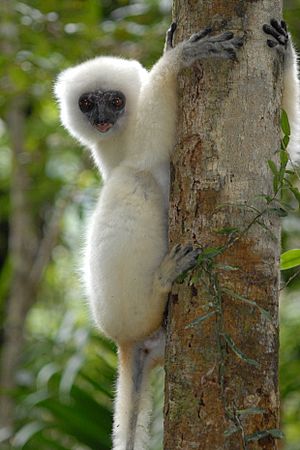Silky sifaka facts for kids
Quick facts for kids Silky sifaka |
|
|---|---|
 |
|
| Conservation status | |
| Scientific classification | |
| Kingdom: | |
| Class: | |
| Order: | |
| Family: |
Indriidae
|
| Genus: | |
| Binomial name | |
| Propithecus candidus |
|
The silky sifaka (Propithecus candidus) is a large lemur with long, silky white fur. It lives in a small area in northeastern Madagascar. Local people call it the simpona. This amazing animal is one of the rarest mammals on Earth. The IUCN says it's one of the world's 25 most endangered primates.
The silky sifaka is one of nine types of sifakas in the Propithecus group. You can only find this species in a few protected areas. Most of them live in Marojejy National Park and Anjanaharibe-Sud Special Reserve. These places are in the rainforests of northeastern Madagascar.
Contents
Social Life and Habits
The silky sifaka lives in groups of two to nine individuals. They spend most of their day eating and resting. They also enjoy social activities like playing, grooming, and traveling together. Sometimes, female sifakas get to eat before the males.
Like other sifakas from eastern Madagascar, they mostly eat leaves and seeds. They also enjoy fruit, flowers, and even a little bit of soil sometimes.
Reproduction and Family Life
Silky sifakas are seasonal breeders. This means they only mate once a year, usually when the rainy season begins.
It's common for other group members to help care for baby sifakas. This is called non-maternal infant care. Sifakas of all ages and both sexes will often groom, play with, and even carry or nurse babies that are not their own.
Communication
Silky sifakas make many different sounds to talk to each other. They also use their sense of smell a lot for communication. They leave scent marks to share messages with other sifakas in their area.
Threats to Silky Sifakas
The silky sifaka is critically endangered. This means there are very few of them left in the wild. Their numbers are decreasing because of several reasons.
- Habitat Loss: Their forest homes are being cut down. People clear land for farming, which is often done by slash-and-burn methods. Trees are also cut for wood.
- Hunting: Sadly, silky sifakas and other lemurs are sometimes hunted by people in their natural habitat.
Efforts are being made to protect these special animals and their forest homes.
Images for kids
See also
 In Spanish: Sifaca sedoso para niños
In Spanish: Sifaca sedoso para niños





